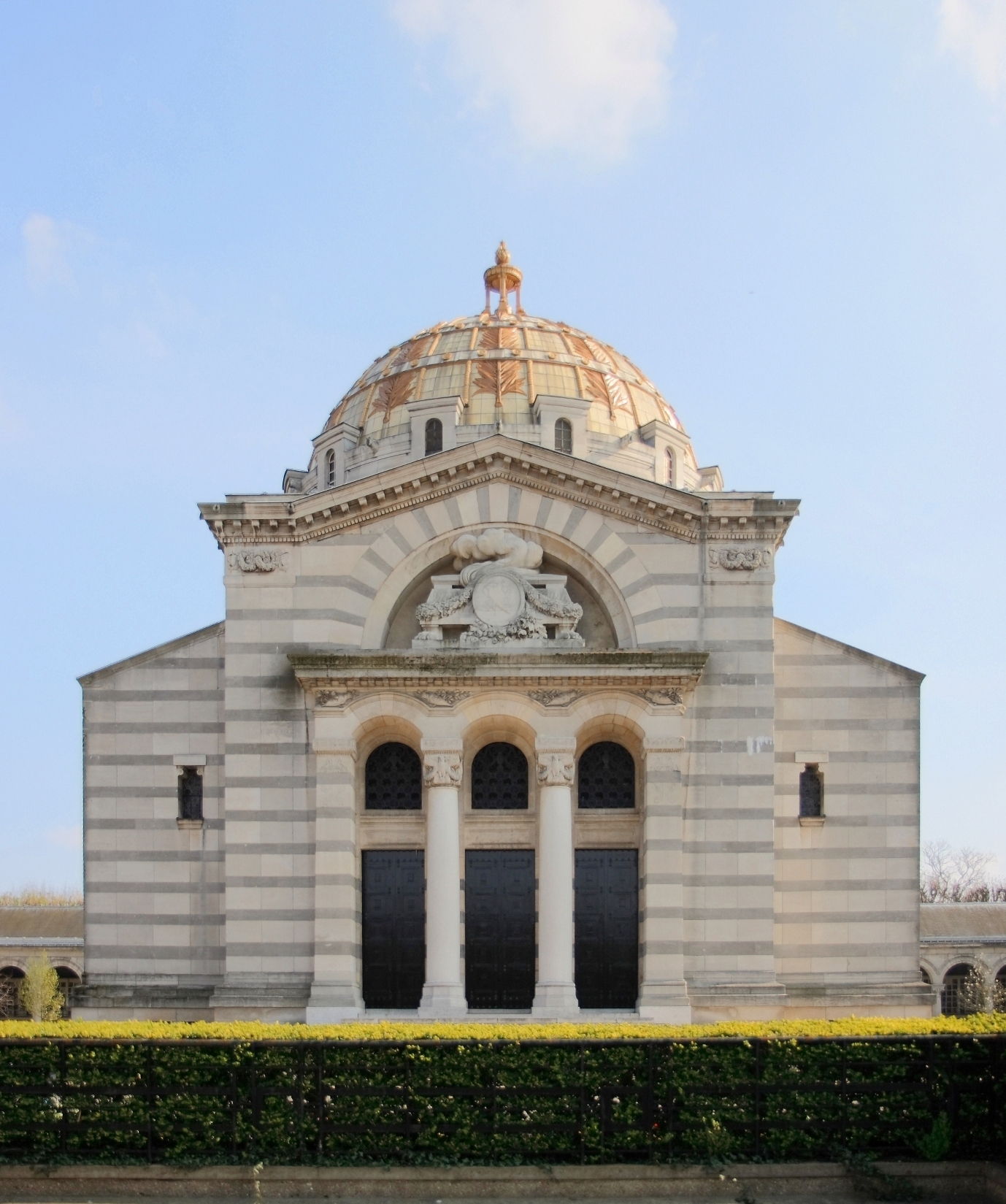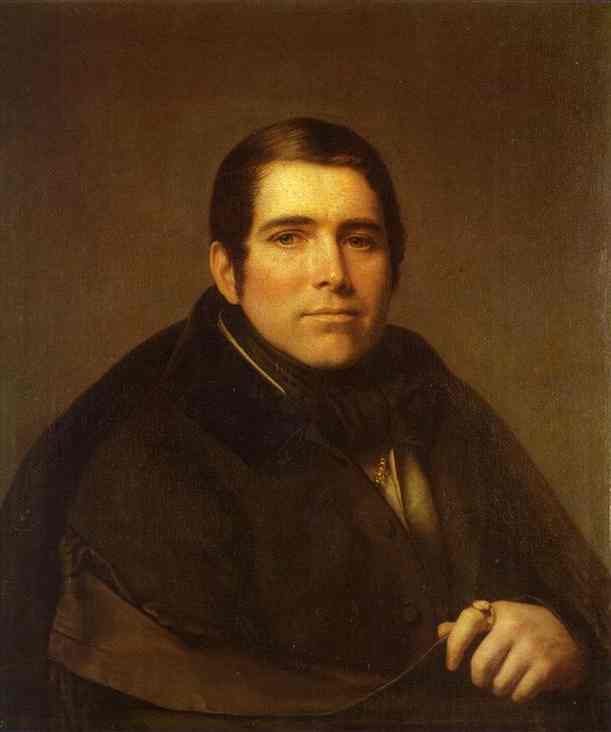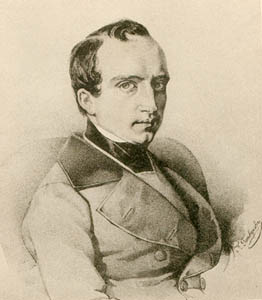|
Alexandra Smirnova
Alexandra Osipovna Smirnova (russian: Александра Осиповна Смирнова, née Rosset, known also as Smirnova-Rosset, Russian: Смирнова-Россет; (6 March 1809, Odessa, Russian Empire – 7 June 1882, Paris, France) was a Russian Imperial court lady-in-waiting who served first widow Empress Maria Fyodorovna, then, after her death in 1828, Empress Alexandra Fyodorovna. Alexandra Rosset (who in 1832 married Russian diplomat Nikolai Smirnov), was an elitist Saint Petersburg salon hostess and a friend of Alexander Pushkin, Vasily Zhukovsky, Pyotr Vyazemsky, Nikolai Gogol and Mikhail Lermontov. She is best remembered for her memoirs, unusually frank, occasionally caustic, and, as it was argued decades later, not necessarily accurate. Early life She was the eldest daughter in a large Odessa family (Alexandra had four more brothers). Her parents were Osip Ivanovich, an officer of the Russian army, friend and distant relative of Duke Richelie ... [...More Info...] [...Related Items...] OR: [Wikipedia] [Google] [Baidu] |
Pyotr Sokolov (portraitist)
Pyotr Fyodorovich Sokolov (russian: link=no, Пётр Фёдорович Сóколов) (1791, Moscow – , Merchik, Kharkov Governorate) was a Russian aquarelle portraitist who painted many of the most distinguished figures of the Pushkin era. He was the father of the painters Pyotr Sokolov, Pavel Sokolov and Alexander Sokolov. Early life Sokolov was born in Moscow, and between the years of 1800 to 1809 he attended Imperial Academy of Arts where he studied with Alexei Yegorov and Vasily ShebuyevBibliographical article in Russia"Соколов Петр Федорович [1791 - 1848]" Retrieved 1 April 2014. who both were very famous and respected artists. In 1809, Sokolov painted "Andromache Mourning Hector" ("Андромаха оплакивает убитого Гектора") for his institution's competition, receiving a minor gold medal as well as the title of "Artist". As part of the Academy's offerings, the students who won the major gold medal wer ... [...More Info...] [...Related Items...] OR: [Wikipedia] [Google] [Baidu] |
Saint Petersburg
Saint Petersburg ( rus, links=no, Санкт-Петербург, a=Ru-Sankt Peterburg Leningrad Petrograd Piter.ogg, r=Sankt-Peterburg, p=ˈsankt pʲɪtʲɪrˈburk), formerly known as Petrograd (1914–1924) and later Leningrad (1924–1991), is the List of cities and towns in Russia by population, second-largest city in Russia. It is situated on the Neva River, at the head of the Gulf of Finland on the Baltic Sea, with a population of roughly 5.4 million residents. Saint Petersburg is the List of European cities by population within city limits, fourth-most populous city in Europe after Istanbul, Moscow and London, the List of cities and towns around the Baltic Sea, most populous city on the Baltic Sea, and the world's List of northernmost items#Cities and settlements, northernmost city of more than 1 million residents. As Russia's Imperial capital, and a Ports of the Baltic Sea, historically strategic port, it is governed as a Federal cities of Russia, federal city. ... [...More Info...] [...Related Items...] OR: [Wikipedia] [Google] [Baidu] |
Père Lachaise Cemetery
Père Lachaise Cemetery (french: Cimetière du Père-Lachaise ; formerly , "East Cemetery") is the largest cemetery in Paris, France (). With more than 3.5 million visitors annually, it is the most visited necropolis in the world. Notable figures in the arts buried at Père Lachaise include Michel Ney, Frédéric Chopin, Émile Waldteufel, Édith Piaf, Marcel Proust, Georges Méliès, Marcel Marceau, Sarah Bernhardt, Oscar Wilde, Thierry Fortineau, J.R.D. Tata, Jim Morrison and Sir Richard Wallace. The Père Lachaise is located in the 20th arrondissement and was the first garden cemetery, as well as the first municipal cemetery in Paris. It is also the site of three World War I memorials. The cemetery is located on the Boulevard de Ménilmontant. The Paris Métro station Philippe Auguste on Line 2 is next to the main entrance, while the station Père Lachaise, on both Line 2 and Line 3, is 500 meters away near a side entrance. History and description Origin The cemetery of ... [...More Info...] [...Related Items...] OR: [Wikipedia] [Google] [Baidu] |
Mariánské Lázně
Mariánské Lázně (; german: Marienbad) is a spa town in Cheb District in the Karlovy Vary Region of the Czech Republic. It has about 12,000 inhabitants. Most of the town's buildings come from its Golden Era in the second half of the 19th century, when many celebrities and top European rulers came to enjoy the curative carbon dioxide springs. The town centre with the spa cultural landscape is well preserved and is protected by law as an urban monument reservation. In 2021, the town became part of the transnational UNESCO World Heritage Site under the name "Great Spa Towns of Europe" because of its springs and architectural testimony to the popularity of spa towns in Europe during the 18th through 20th centuries. Administrative parts The town is made up of town parts and villages of Mariánské Lázně, Hamrníky, Chotěnov-Skláře, Kladská, Stanoviště and Úšovice. Geography Mariánské Lázně is located about southeast of Cheb and southwest of Karlovy Vary. The munic ... [...More Info...] [...Related Items...] OR: [Wikipedia] [Google] [Baidu] |
Karlovy Vary
Karlovy Vary (; german: Karlsbad, formerly also spelled ''Carlsbad'' in English) is a spa city in the Karlovy Vary Region of the Czech Republic. It has about 46,000 inhabitants. It lies on the confluence of the rivers Ohře and Teplá. It is named after Charles IV, Holy Roman Emperor and the King of Bohemia, who founded the city. Karlovy Vary is the site of numerous hot springs (13 main springs, about 300 smaller springs, and the warm-water Teplá River), and is the most visited spa town in the Czech Republic. The historic city centre with the spa cultural landscape is well preserved and is protected by law as an urban monument reservation. It is the largest spa complex in Europe. In 2021, the city became part of the transnational UNESCO World Heritage Site under the name " Great Spa Towns of Europe" because of its spas and architecture from the 18th through 20th centuries. Administrative parts Karlovy Vary is made up of 15 city parts and villages: *Karlovy Vary *Bohati ... [...More Info...] [...Related Items...] OR: [Wikipedia] [Google] [Baidu] |
Berlin
Berlin is Capital of Germany, the capital and largest city of Germany, both by area and List of cities in Germany by population, by population. Its more than 3.85 million inhabitants make it the European Union's List of cities in the European Union by population within city limits, most populous city, as measured by population within city limits having gained this status after the United Kingdom's, and thus London's, Brexit, departure from the European Union. Simultaneously, the city is one of the states of Germany, and is the List of German states by area, third smallest state in the country in terms of area. Berlin is surrounded by the state of Brandenburg, and Brandenburg's capital Potsdam is nearby. The urban area of Berlin has a population of over 4.5 million and is therefore the most populous urban area in Germany. The Berlin/Brandenburg Metropolitan Region, Berlin-Brandenburg capital region has around 6.2 million inhabitants and is Germany's second-largest metropolitan reg ... [...More Info...] [...Related Items...] OR: [Wikipedia] [Google] [Baidu] |
Winter Palace
The Winter Palace ( rus, Зимний дворец, Zimnij dvorets, p=ˈzʲimnʲɪj dvɐˈrʲɛts) is a palace in Saint Petersburg that served as the official residence of the Emperor of all the Russias, Russian Emperor from 1732 to 1917. The palace and its precincts now house the Hermitage Museum. Situated between Palace Embankment and Palace Square, adjacent to the site of Peter the Great's original Winter Palace, the present and fourth Winter Palace was built and altered almost continuously between the late 1730s and 1837, when it was severely damaged by fire and immediately rebuilt. The storming of the palace in 1917, as depicted in Soviet art and in Sergei Eisenstein's 1928 film ''October'', became an iconic symbol of the Russian Revolution. The emperors constructed their palaces on a monumental scale that aimed to reflect the might and power of Russian Empire, Imperial Russia. From the palace, the tsars ruled over (almost 1/6 of the Earth's landmass) and Russian Empire Ce ... [...More Info...] [...Related Items...] OR: [Wikipedia] [Google] [Baidu] |
Pyotr Pletnyov
Pyotr Alexandrovich Pletnyov (russian: Пётр Александрович Плетнёв; , Tebleshi, Tver Governorate — ) was a minor Russian poet and literary critic, who rose to become the dean of the Saint Petersburg University (1840–61) and academician of the Petersburg Academy of Sciences (1841). Pletnyov befriended the poet Alexander Pushkin, who dedicated his novel in verse ''Eugene Onegin'' to him. After Pushkin's death in 1837, Pletnyov edited his literary journal ''Sovremennik'' until the latter was sold to Nikolai Nekrasov in 1846. As a critic, he was strongly opposed to Vissarion Belinsky and like-minded journalists who placed "progressive ideas" above the artistic mastership. With Sergey Uvarov's support, Pletnyov gained many teaching assignments, in and around Saint Petersburg, including in the end a tutor's post to the future Alexander II. His non-partisan view of various literary movements helped him to single out and applaud all of the most gifted ... [...More Info...] [...Related Items...] OR: [Wikipedia] [Google] [Baidu] |
Vladimir Odoyevsky
Prince Vladimir Fyodorovich Odoyevsky (russian: Влади́мир Фёдорович Одо́евский, p=ɐˈdojɪfskʲɪj; Владимир Федорович Одоевский. Библиографический указатель. Энциклопедия Хоронос//http://hrono.ru/biograf/bio_o/odoevski_vf.php – ) was a prominent Russian Imperial philosopher, writer, music critic, philanthropist and pedagogue. He became known as the "Russian Hoffmann" and even the "Russian Faust" on account of his keen interest in phantasmagoric tales and musical criticism. Biography The last member of the princely House of Odoyev, he was genealogically the most senior member of the House of Rurik. He was born to Prince Fyodor Sergeevich Odoyevsky (1771–1808), a state councillor (''statsky sovietnik''). His father started out as an adjutant of Prince Grigory Potyomkin, then, in 1798 he entered civil service as the director of the Moscow Assignant bank. According to one versio ... [...More Info...] [...Related Items...] OR: [Wikipedia] [Google] [Baidu] |
Alexander Koshelev
Alexander Ivanovich Koshelev (russian: Александр Иванович Кошелев; 21 May 1806 – 24 November 1883) was a Russian journalist, publicist, publisher and state official. A staunch Slavophile, Koshelev published numerous essays, mostly on economics. In the late 1850s he authored one of the several alternative land reform projects which the Russian government had to consider before embarking upon the Emancipation reform of 1861. In 1856 Koshelev started publishing the magazine ''Russkaya Beseda'' and two years later became its editor. Later, he published the Moscow journals ''Beseda'' (1871—1872, edited by Sergey Yuriev) and (in 1880—1882) ''Zemstvo'' (edited by Vasily Skalon), both projecting the Slavophile views upon the agricultural issues and supporting the concept of obshchina as a true foundation for the Russian rural community. Koshelev worked for several governmental offices, in the Moscow and Ryazan Governorates, but also in Poland (then part of ... [...More Info...] [...Related Items...] OR: [Wikipedia] [Google] [Baidu] |
Nikolay Karamzin
Nikolay Mikhailovich Karamzin (russian: Николай Михайлович Карамзин, p=nʲɪkɐˈlaj mʲɪˈxajləvʲɪtɕ kərɐmˈzʲin; ) was a Russian Empire, Russian Imperial historian, romantic writer, poet and critic. He is best remembered for his fundamental ''History of the Russian State'', a 12-volume national history. Early life Karamzin was born in the small village of Mikhailovka (modern-day Karamzinka village of the Ulyanovsk Oblast, Russia) near Simbirsk in the Znamenskoye family estate. Another version exists that he was born in 1765 in the Mikhailovka village of the Orenburg Governorate (modern-day Preobrazhenka village of the Orenburg Oblast, Russia) where his father served, and in recent years Orenburg historians have been actively disputing the official version.''Mikhail Pogodin (1866)''Nikolai Mikhailovich Karamzin. Based on Writings, Letters and Opinions — Moscow: A. I. Mamontov Publishing, p. 1-3''Albert Starchevsky (1849)''Nikolai Mikhailovic ... [...More Info...] [...Related Items...] OR: [Wikipedia] [Google] [Baidu] |




.jpg)



